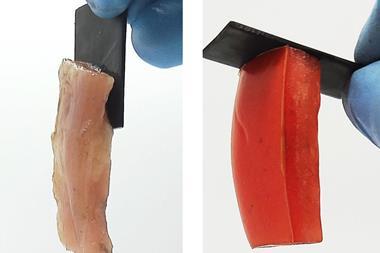Discovery may help scientists design new underwater adhesives
The tough, extendable, energy-dissipating properties of the casemaker caddisfly’s adhesive silk are down to a self-recovering network of calcium crosslinks, new research shows. US researchers behind the discovery hope to harness these findings to design new synthetic bioadhesives that can adhere to wet tissues.

Casemaker caddisflies live at the bottom of fast moving streams. They manage to survive the mechanical onslaught of such a rough, underwater environment by weaving together small stones with their silk, which acts as an underwater sticky tape, to make a protective stone casing.
Now, Russell Stewart and Nicholas Ashton from the University of Utah have probed the molecular structure of caddisfly silk to understand how it can withstand external force and maintain the casing. Working with fibres that were typically 3mm long and 10µm in diameter and mounting these on a custom-designed test system proved to be fiddly work, but ‘Nic, who made the measurements, has the hands and dexterity of a fine jeweller,’ explains Stewart.

Applying a controlled stretching force to single caddisfly silk fibres revealed that they can be stretched to more than twice their initial length. When a stretched fibre is released, they show it does not snap back like elastic bands do as a result of stored energy. Instead, the initially slack fibres spontaneously self-recover their shape, length, strength and stiffness in a more controlled manner through the reversible sacrificial rupture of Ca2+ -crosslinks within two types of Ca2+ -containing environments in two of the non-covalent networks found in their multi-network makeup. The rupturing dissipates the strain energy and when the stretch is released the ruptured areas in the network gradually reform the structure near to its original state. Together with a third covalent network, the fibres function like shock-absorbers, reversibly absorbing and dissipating stretching energy, allowing the adhesive bond between the stones in the caddisfly’s body casing to be maintained.
Polymer scientist Ali Dhinojwala, from the University of Akron in the US, says the work sheds important light on the use of Ca2+ -mediated cross-bridges in recovering the strength of the sticky silk produced by the casemaker caddisfly. ‘It also provides insight for the design of synthetic hydrogels that far exceed the strength of these natural materials.’
‘Living organisms have limited materials to work with and severe processing constraints that materials technologists do not have,’ says Stewart. ‘I am confident we will be able to create practical, cost-effective synthetic materials that exceed the qualities of this natural sticky silk’.
References
This article is free to access until 26 February 2015. Download it here:
N N Ashton and R J Stewart, Soft Matter, 2015, DOI: 10.1039/c4sm02435d












No comments yet